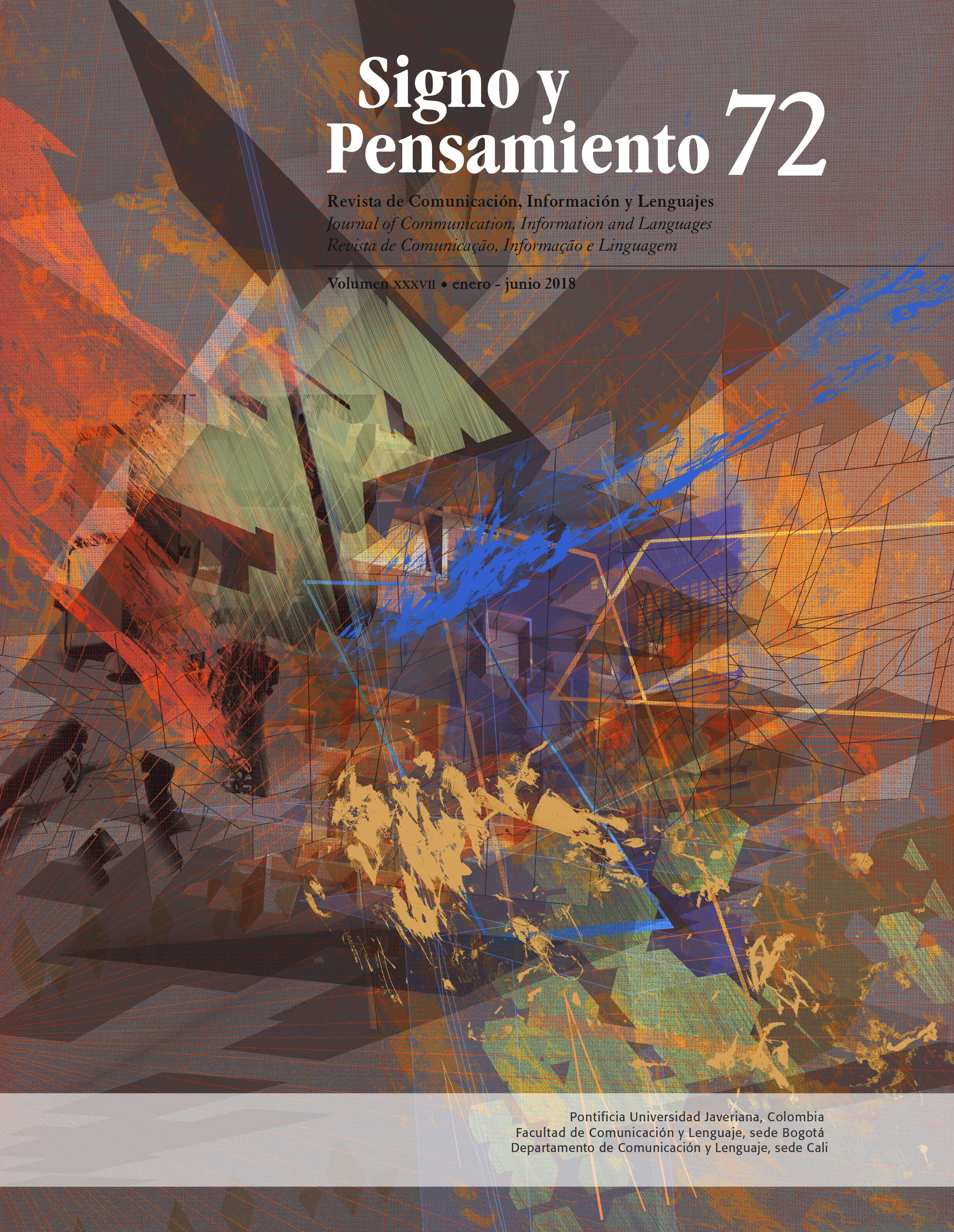Abstract
This article deals with some textual crossings of biblical discourse and the political discourse produced in the journalistic discourse of opinion called “column”, based on a contingent political news event the “Caval case”, which involves the Chilean presidential family, generating varied senses. The methodology consists on the textual analysis of a column published in a newspaper of national circulation in Chile, titled “The son’s martyrdom”, from a discursive and contextual perspective.
Beaugrande, R. & Dressler, W. (1997). Introducción a la lingüística del texto. Barcelona: Ariel.
Colodro, M. (2015a). “De menos a Max” [en línea], disponible en: http://voces.latercera.com/autor/max-colodro/, recuperado: 14 de enero de 2017.
Colodro, M. (7 de junio de 2015b). El martirio del hijo. La Tercera. Santiago.
Charaudeau, P. (2011). Le discours politique ou le pouvoir du langage. Paris: Université de Paris 13. Recuperé de http://www.youscribe.com/catalogue/rapports-et-theses/savoirs/sciences-humaines-et-sociales/le-discours-politique-ou-le-pouvoir-du-langage-304525, recuperado: 10 de enero de 2017.
Charaudeau, P. (2012). Entre la pragmática y las teorías de la enunciación. Entrevista a Patrick Charaudeau. En O. Londoño, Poliedros discursivos. Miradas a los Estudios del Discurso (pp. 97-106). Villa María: Eduvim.
Charaudeau, P. (2014). “L’art de mentir en politique”. Sciences Humaines 256 [Recuperé janvier 5, 2017 de http://www.patrick-charaudeau.com/IMG/pdf/L_art_de_mentir_en_politique.pdf :.
Disselkoen, H.R.O. (2003). Razón e ironía. Revista philosophica, 26, 181-194.
Genette, G. (1989). Palimpsestos: la literatura en segundo grado. Madrid: Taurus.
Geninasca, J. (1997). La Parole littéraire. Paris: Presses Universitaires de France.
Geninasca, J. (1998). Le Discours n'est pas toujours ce que l'on croit, Protée, 26(1), 109-118.
Godoy, M. (2015, febrero 16). El caso Caval explicado con manzanitas. Economía para todos Con manzanitas. Recuperado de https://economiatodos.cl/2015/02/16/la-gravedad-del-caso-davalos-caso-nueragate/
Hutcheon, L. (1981). Ironie, Satire, Parodie: une approche pragmatique de l'ironie. Poetique, 140-155. Recuperado de https://tspace.library.utoronto.ca/bitstream/1807/10253/1/TSpace0166.pdf
La Sagrada Biblia. (1968). Chicago: The Catholic Press.
López, C. (2014). Análisis del discurso. Madrid: Síntesis.
Luchetti, E. (2005). Didáctica de la Lengua. Buenos Aires: Bonum.
Maingueneau, D. (2009). Introduction. La difficile émergence d’une analyse du discours religieux. Langage et sociéte, 130(4), 5-13. https://doi.org/10.3917/ls.130.0005.
Maquiavelo, N. (2009). El príncipe. Barcelona: Brontes.
Martínez, J. (1997). Curso general de redacción periodística. Madrid: Paraninfo.
Mendoza, A. (coord.). (2008). Textos entre textos. Las conexiones textuales en la formación del lector. Barcelona: Horsori.
MINEDUC. (2015a). Bases Curriculares. Lengua y Literatura. Santiago: Unidad de Currículum y Evaluación.
MINEDUC. (2015b). Programa de Estudio de Lenguaje y Comunicación, de 3° Año de Enseñanza Media. Santiago: Unidad de Currículum y Evaluación.
Parodi, G. (ed.). (2008). Géneros académicos y géneros profesionales: Accesos discursivos para saber y hacer. Valparaíso: Ediciones Universitarias de Valparaíso.
Perelman, Ch. & Olbrechts-Tyteca, L. (2006). Tratado de la argumentación. La nueva retórica. Madrid: Gredos.
Pérez, M. & Vega, O. (2003). Técnicas argumentativas. Santiago: Ediciones Universidad Católica de Chile.
Real Academia Española [RAE]. (2014). Diccionario de la lengua Española (DEL). Madrid: Espasa.
Van Dijk, T.; Mendizábal, I. (1999). Análisis del discurso social y político. Quito: ABYA-YALA.
Van Dijk, T. (2009). El discurso como estructura y proceso. Barcelona: Gedisa.
Van Dijk, T. (2010). El discurso como interacción social. Barcelona: Gedisa.
Van Dijk, T. (2015). Cincuenta años de estudios del discurso. Discurso & Sociedad, 9(1-2), 15-32. Recuperado de http://www.dissoc.org/ediciones/v09n01-2/DS9(1-2)VanDijk.pdf
This journal is registered under a Creative Commons Attribution 4.0 International Public License. Thus, this work may be reproduced, distributed, and publicly shared in digital format, as long as the names of the authors and Pontificia Universidad Javeriana are acknowledged. Others are allowed to quote, adapt, transform, auto-archive, republish, and create based on this material, for any purpose (even commercial ones), provided the authorship is duly acknowledged, a link to the original work is provided, and it is specified if changes have been made. Pontificia Universidad Javeriana does not hold the rights of published works and the authors are solely responsible for the contents of their works; they keep the moral, intellectual, privacy, and publicity rights.
Approving the intervention of the work (review, copy-editing, translation, layout) and the following outreach, are granted through an use license and not through an assignment of rights. This means the journal and Pontificia Universidad Javeriana cannot be held responsible for any ethical malpractice by the authors. As a consequence of the protection granted by the use license, the journal is not required to publish recantations or modify information already published, unless the errata stems from the editorial management process. Publishing contents in this journal does not generate royalties for contributors.



